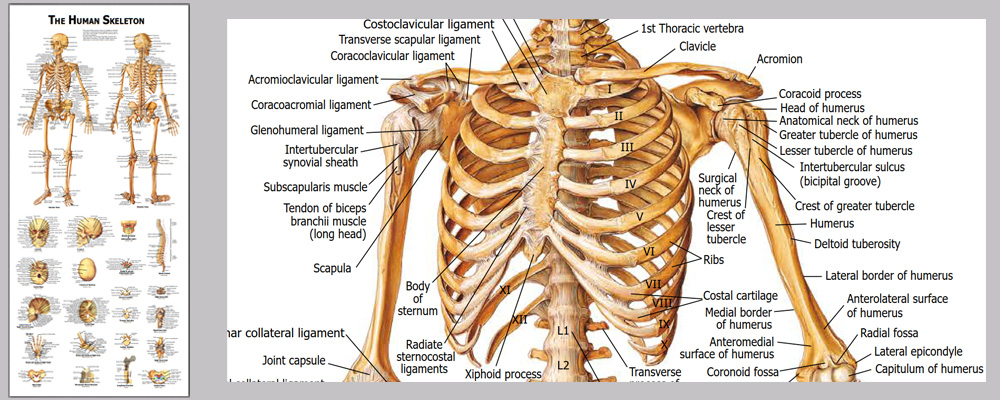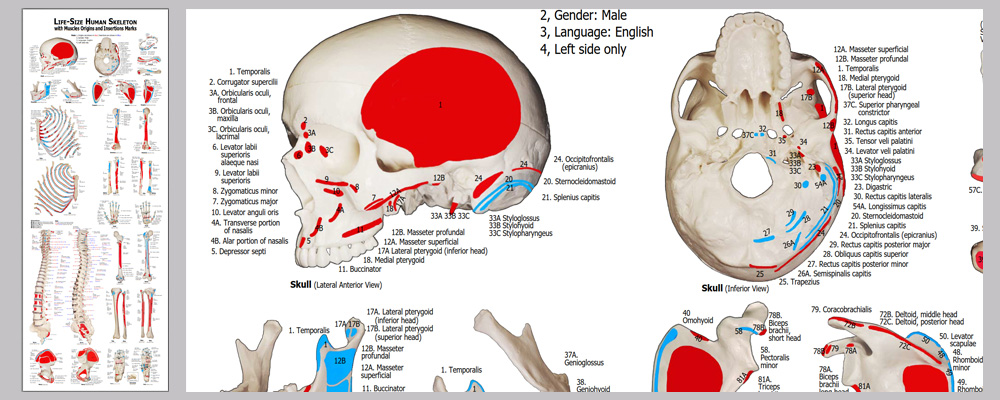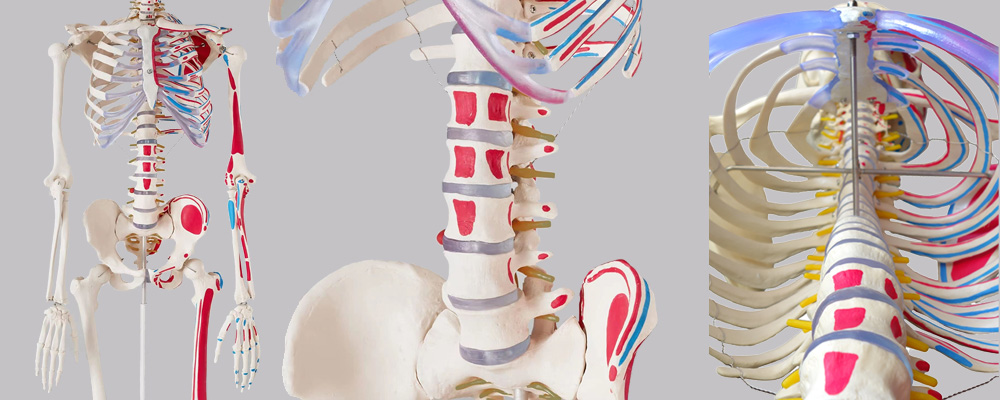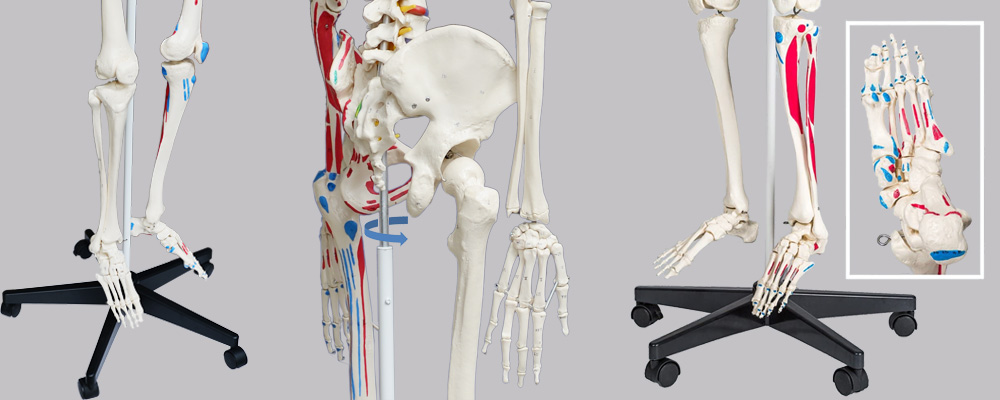human skeleton model with labels rear view
This life size articulated adult human skeleton model is 180cm tall & ideal for teaching / learning the basics of human anatomy. Includes a colorful Human Skeleton chart to show all the detailed structures for reference.Detailed colorful chart with over 630 accurate definitions. Durable and no reflection with matte film covered, 36 * 78cm

Detailed muscles origins and insertions with codes. Durable and no reflection with matte film covered, 100cm * 38cm

Stainless steel wires keep the ribs gaps stable.

2 of 5 casters are lockable.

An overview of JC anatomy advantages: • Hand-painted muscle origins and insertions • Flexible spine and ligaments • Slipped disc between the 3rd and 4th lumbar vertebrae • Protruding spinal nerves and vertebral arteries • 3-part assembled skull with individually inserted teeth • Made from a durable, unbreakable synthetic material • Top quality, life size natural casting • lMultiple Applications -decorate,decorate,human movement, etc. • lChart - Detailed colorful chart with about 769 accurate definitions. Durable and no reflection with matte film covered, 36 * 78cm • On a stable metal stand with 5 casters (painted white) • Full size dust cover keeps model clean while in storage • Exceptional value for money with a 3 year guarantee • human skeleton model with labels rear view Easy to use - Main joints are movable. Skull, skullcap arms, legs, crus, feet are removable.
| Product name | human skeleton model with labels rear view |
| Place of Origin | Shenzhen China |
| Product Material | PVC, ABS, SST |
| Rib cage | A 5mm dia |
| Human skeleton model life | 13years |
| Surface treatment | Polish. Etched. Texture |
| SUPPORT 24/7 | Contact us 24 hours a day, 7 days a week |
| Size | 72 * 77 * 93 |
| Port | Shenzhen |
| PAYMENT & ORDERING | PayPal account or pay by credit card |
human skeleton model with labels rear view FAQs Guide Are you looking for a quick review guide about human skeleton model with labels rear view? An ultimate FAQs buying guide is available to help you.This guide contains all the information about all the important facts, figures, and various processes regarding human skeleton model with labels rear view. Let’s continue!
2.About human skeleton model with labels rear view payment method
3.What are the different types of human skeleton model with labels rear view available?
4.How much weight can human skeleton model with labels rear view hold?
5.How can a human skeleton model with labels rear view be utilized for rehabilitation and physiotherapy purposes?
6.What kind of material is used to make the human skeleton model with labels rear view?
7.Can bone diseases such as osteoporosis be displayed on the human skeleton model with labels rear view?
8.Is it possible to color code this human skeleton model with labels rear view to represent different bone parts?
9.What aspects of bone structure can be observed in this human skeleton model with labels rear view?
10.Are human skeleton model with labels rear view joints elastic and flexible?
11.How durable is human skeleton model with labels rear view?
12.About human skeleton model with labels rear view raw materials
13.Is this human skeleton model with labels rear view suitable for anatomy learning?
14.How many thoracic and lumbar vertebrae are there in the human skeleton model with labels rear view?
1.About human skeleton model with labels rear view delivery date
Around 40 days. Depends on qty.
2.About human skeleton model with labels rear view payment method
TT, or Paypal
3.What are the different types of human skeleton model with labels rear view available?
1. Anatomical Skeleton Models: These models are exact replicas of the human skeletal system and are used for educational and medical purposes. They are typically made of high-quality materials such as plastic or resin and come with detailed labels for each bone, making it easy to identify and study different structures. 2. Disarticulated Skeleton Models: These models consist of individual bones that can be separated from each other. They are often used in classrooms for teaching purposes as they allow students to handle and study each bone individually, facilitating a more hands-on learning experience. 3. Flexible Skeleton Models: These models are made from a flexible material such as rubber or PVC and are designed to mimic the movements of the human body. They are often used in medical training and rehabilitation settings to demonstrate muscle and joint movements. 4. Life-size Skeleton Models: As the name suggests, these models are the same size as an actual human skeleton. They are most commonly used in medical schools and hospitals for teaching and training purposes.
4.How much weight can human skeleton model with labels rear view hold?
The amount of weight a human skeleton model can hold depends on the materials used to make it and the structural integrity of the model. Generally, a human skeleton model made from plastic or resin can hold up to 5-10 pounds of weight. However, this weight limit may vary depending on the size and design of the model. If the model is designed to be articulated and movable, it may have a lower weight limit as the joints and connections may not be able to support heavy weights. On the other hand, a solid and non-articulated skeleton model made from sturdy materials such as metal or wood may have a higher weight limit of around 20-30 pounds.
5.How can a human skeleton model with labels rear view be utilized for rehabilitation and physiotherapy purposes?
Demonstrate the right bone parts postion relationships can help doctors and patients to understanhuman skeleton model can be a valuable tool for rehabilitation and physiotherapy purposes as it can aid in teaching and demonstrating proper body mechanics, identifying and addressing musculoskeletal imbalances and dysfunctions, and monitoring progress in treatment. Here are some ways in which a human skeleton model can be utilized for rehabilitation and physiotherapy purposes: 1. Education: A human skeleton model can be used to educate patients and clients about the structure and function of the human body. This can help them understand their injuries or conditions better, and also make them more aware of how their body moves and functions. 2. Creating personalized treatment plans: With the help of a skeleton model, therapists can design personalized treatment plans for each individual patient. This can include exercises and movements targeted at specific areas of the body that need strengthening or stretching.d the right way of rehabilitation and physiotherapy.
6.What kind of material is used to make the human skeleton model with labels rear view?
The human skeleton model is typically made out of a combination of materials, depending on the specific model and its intended use. Generally, the main materials used are plastic, metal, and sometimes, natural materials such as wood. Plastic: The majority of the skeleton model is made from a high-quality, durable plastic such as polyvinyl chloride (PVC) or polyethylene. These materials are lightweight and easy to mold into the intricate and specific shapes required for each bone in the skeleton. They are also easy to paint and can be colored to resemble real bones.
7.Can bone diseases such as osteoporosis be displayed on the human skeleton model with labels rear view?
Yes, bone diseases like osteoporosis can be displayed on a human skeleton model. A human skeleton model is a representation of the bones and joints of the human body and can be used to educate and train students and medical professionals. Osteoporosis is a bone disease that results in weakened and porous bones, increasing the risk of fractures. As a result, there are certain features and changes in the bone structure that can be seen on a human skeleton model.
8.Is it possible to color code this human skeleton model with labels rear view to represent different bone parts?
Yes, it is possible to color code a human skeleton model to represent different bone parts. This can be done through the use of different colored paints, markers, or even colored stickers. The specific colors used will depend on the preferences of the person creating the model and the level of detail they wish to include.
9.What aspects of bone structure can be observed in this human skeleton model with labels rear view?
1. Long bones: The long bones of the skeleton model, such as the femur, tibia, and humerus, have a cylindrical shape and are longer than they are wide. They also have distinct features such as a rounded head at one end and an expanded area at the other end for attachment points of muscles and ligaments. 2. Short bones: The carpals in the wrist and tarsals in the foot are examples of short bones that are generally cube-shaped and are specialized for mobility and flexibility. These bones can be seen in the skeleton model as small, compact bones. 3. Flat bones: The flat bones of the skeleton, such as the skull, sternum, and scapula, are thin and flattened, providing protection for internal organs or attachment sites for muscles. These bones can be observed in the skeleton model as flat and smooth. 4. Irregular bones: The irregular bones, such as the vertebrae and pelvis bones, have complex shapes and vary in size and structure. The spine and hip bones can be identified on the skeleton model as examples of irregular bones.
10.Are human skeleton model with labels rear view joints elastic and flexible?
The human skeleton model joints are not entirely elastic and flexible, as they include various types of joints with different levels of flexibility. The elasticity and flexibility of a joint depend on its structure and function.
11.How durable is human skeleton model with labels rear view?
The durability of a human skeleton model can vary depending on the materials used and the quality of construction. However, generally speaking, a high-quality skeleton model can be quite durable and can last for many years if properly cared for. Here are some factors that can affect the durability of a human skeleton model: 1. Materials: The most common materials used for human skeleton models are plastic, resin, and wood. Plastic and resin models are generally more durable as they are less prone to damage from impacts or moisture. Wood models can also be quite durable, but they may be more susceptible to wear and tear over time. 2. Maintenance: Proper maintenance and care can significantly increase the durability of a human skeleton model. Regular cleaning with a soft cloth and mild detergent can help keep the model free of dust and dirt. Additionally, storing the model in a protective case or covering can also help prevent damage. Overall, a high-quality human skeleton model can be quite durable and can last for many years with proper care. However, it is important to keep in mind that no model is completely indestructible, and regular wear and tear can occur over time.
12.About human skeleton model with labels rear view raw materials
PVC, ABS, SST
13.Is this human skeleton model with labels rear view suitable for anatomy learning?
Yes, this human skeleton model is suitable for anatomy learning for several reasons. 1. Lifelike appearance: The model closely resembles the human skeleton in terms of size, shape, and detail. This makes it easier for students to visualize and understand the placement and functioning of bones in the human body. 2. Detailed labeling: The model comes with detailed labeling of all the bones and structures, helping students to learn the correct terminology and understand the location and function of each bone. 3. Removable parts: The model has removable limbs, joints, and other parts, allowing students to explore and study the underlying supportive, connective, and reproductive structures, such as ligaments, tendons, and cartilage. 4. Durable materials: The model is made of high-quality, durable materials that can withstand regular handling, making it suitable for use in classrooms, laboratories, and homes. 5. Realistic movement: The model's limbs can be moved in a way similar to human movement, making it an effective tool for demonstrating physiological processes and the range of motion of different joints. 6. Interactive learning: This model can be used in interactive learning sessions, such as small group discussions and hands-on activities, to foster a deeper understanding of the human skeleton and its functioning.
14.How many thoracic and lumbar vertebrae are there in the human skeleton model with labels rear view?
There are 12 segments in the thoracic vertebrae, 5 segments in the lumbar vertebraeGenerally, there are 12 thoracic vertebrae and 5 lumbar vertebrae in the human skeleton model. The thoracic vertebrae are located in the middle region of the spine, between the cervical vertebrae (neck) and lumbar vertebrae (lower back). They are numbered from T1 to T12, with T1 being the first thoracic vertebra closest to the skull and T12 being the last thoracic vertebra closest to the pelvis. The lumbar vertebrae are located in the lower back region, below the thoracic vertebrae. They are numbered from L1 to L5, with L1 being the first lumbar vertebra closest to the thoracic vertebrae and L5 being the last lumbar vertebra closest to the sacrum (a triangular bone at the base of the spine). However, the specific number of thoracic and lumbar vertebrae may vary slightly from person to person due to individual differences in bone structure. Some people may have 11 or 13 thoracic vertebrae, and 4 or 6 lumbar vertebrae. This is known as a variation or anomaly in the number of vertebrae. .




